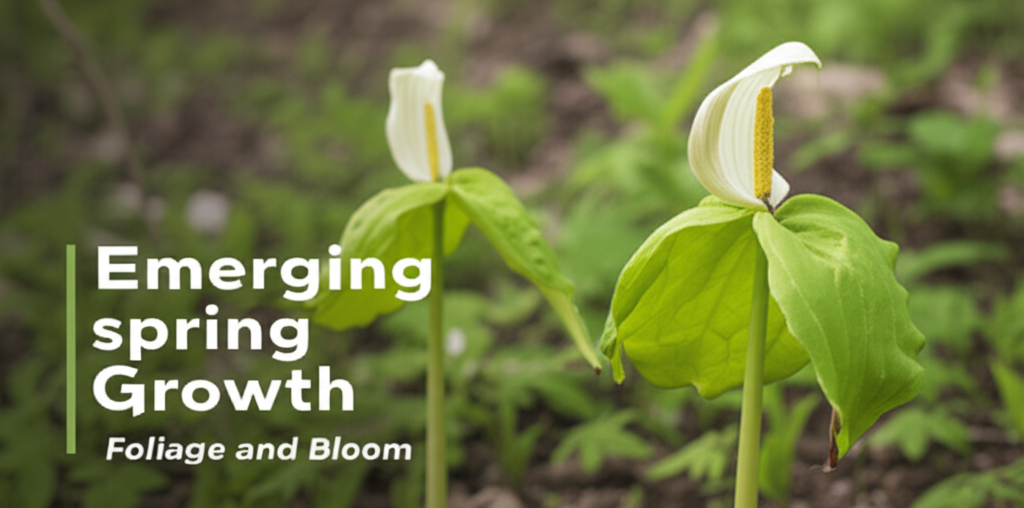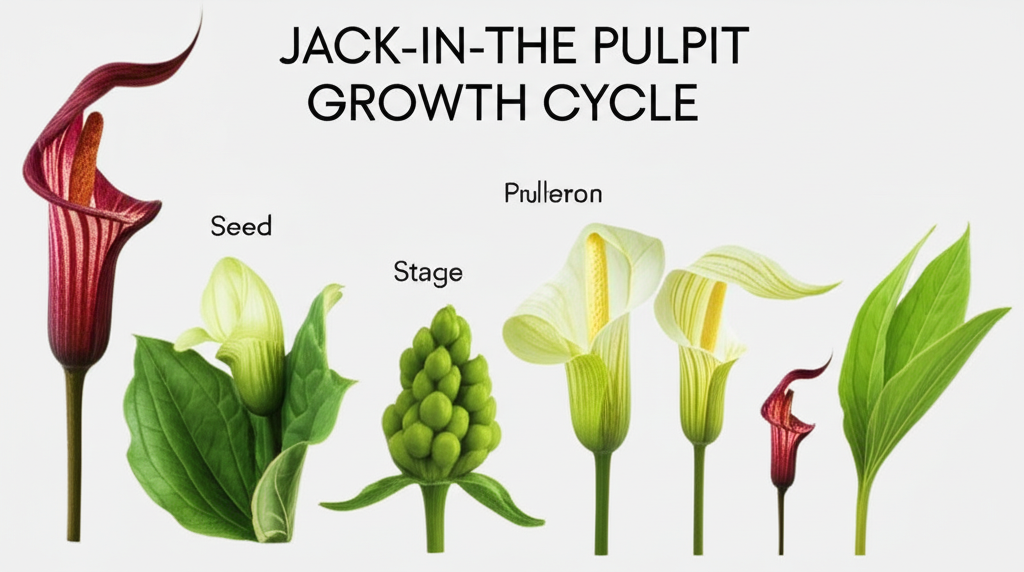The Enigmatic Jack-in-the-Pulpit: More Than Just a Pretty Face
The Jack-in-the-Pulpit (Arisaema triphyllum) is a perennial wildflower renowned for its distinctive and somewhat bizarre bloom. Often found gracing the shaded woodlands and damp, fertile soils of eastern North America, this plant captivates botanists and casual observers alike with its unique reproductive structure. What appears to be a single flower is, in fact, a complex arrangement designed to attract and trap tiny insects, facilitating pollination. Understanding its growth cycle is key to appreciating its ecological role and perhaps even successfully cultivating this woodland gem. This article will delve into every stage of the Jack-in-the-Pulpit’s life, from its subterranean beginnings to its vibrant seasonal display.
The Subterranean Secret: The Corm

The foundation of the Jack-in-the-Pulpit’s existence lies beneath the soil surface in a swollen, underground stem known as a corm. This fleshy organ serves as a vital storage unit, accumulating nutrients throughout the growing season to fuel future growth and reproduction.
Corm Development and Function
The corm is a true marvel of botanical engineering. It stores carbohydrates, primarily in the form of starch, which are produced by the plant’s leaves during photosynthesis. This stored energy is crucial for the plant’s survival through the dormant winter months and provides the initial boost needed for spring growth. The corm also contains buds from which new shoots and roots will emerge.
Annual Corm Growth
Each year, the Jack-in-the-Pulpit corm undergoes a cycle of growth and replenishment. As the plant matures and photosynthesizes, it adds a new layer of tissue to the corm, essentially increasing its size and energy reserves. This annual growth pattern is essential for the plant’s long-term viability.
From Dormancy to Emergence: The Spring Awakening
As winter’s chill recedes and the forest floor begins to warm, the Jack-in-the-Pulpit corm awakens from its dormancy. This period is marked by rapid development and the emergence of the plant’s iconic structures.
The First Shoots
The first signs of life appear as a pale, pointed shoot pushing through the leaf litter. This initial growth is powered by the energy reserves stored within the corm. Within a short period, this shoot unfurls into the characteristic trifoliate leaves.
Leaf Development
The Jack-in-the-Pulpit typically displays two to three large, compound leaves. Each leaf is divided into three leaflets, giving the plant its specific epithet, triphyllum. These leaves are vital for photosynthesis, the process by which the plant converts sunlight into energy. The larger the leaves, the more energy the plant can produce, contributing to a more robust corm and, potentially, a bloom in subsequent years.
The Birth of the “Pulpit” and “Jack”
The most distinctive feature, the flower spathe and spadix, emerges shortly after the leaves. The spathe is the hooded, leaf-like structure that forms the “pulpit,” often green or purplish-green with stripes. Nestled within this hood is the spadix, the fleshy spike bearing the tiny, inconspicuous flowers. This entire structure, the spathe and spadix, is often referred to as the “flower,” though technically it’s an inflorescence. The arrangement is specifically adapted to attract small insects like gnats and flies.
The Art of Deception: Pollination and Seed Production
The Jack-in-the-Pulpit employs a fascinating strategy to ensure the production of its seeds, relying on a cleverly designed trap to facilitate pollination.
Attracting Pollinators
The spathe’s coloration, often with purplish veins, and its slightly sweet scent are believed to attract pollinators. The spadix, being sterile at the top, may further enhance its allure by providing a landing platform.
The Insect Trap
The spathe forms a vase-like structure, with downward-pointing hairs lining the interior of the spadix. Insects enter the spathe, seeking nectar or shelter, but the hairs prevent them from easily exiting. As they crawl down the spadix, they brush against the true flowers, which are clustered at the base. Pollen adheres to the insects’ bodies. Eventually, the hairs wither, allowing the trapped insects to escape, carrying pollen to other Jack-in-the-Pulpit plants.
Seed Formation
After successful pollination, the spadix and spathe wither and disappear, leaving behind a stalk adorned with a cluster of bright red-orange berries. These berries contain the seeds of the next generation.
The Autumn Transition: Ripening and Dormancy Preparation
As the summer wanes, the Jack-in-the-Pulpit shifts its focus from flowering to seed maturation and preparing its corm for the coming winter.
Berry Maturation
The green berries develop into plump, glossy, and vibrantly colored fruits. These berries are a food source for various birds and small mammals, which in turn aid in seed dispersal.
Nutrient Translocation
Simultaneously, the plant begins to translocate the nutrients produced through photosynthesis from its leaves to the corm. This process is crucial for replenishing the corm’s energy stores, ensuring its survival and the plant’s ability to grow in the following year.
Leaf Senescence
The leaves, having served their photosynthetic purpose, begin to yellow and eventually die back. This senescence is a natural part of the plant’s annual cycle, signaling the transition towards dormancy.
The Winter Slumber: A Period of Rest
With the arrival of frost and snow, the Jack-in-the-Pulpit enters its dormant phase, a critical period of rest and recovery.
Belowground Survival
The aboveground parts of the plant wither and decompose, but the corm remains alive beneath the soil. Protected by a layer of insulating organic matter, it endures the harsh winter conditions. The stored energy within the corm allows it to survive freezing temperatures.
The Cycle Repeats
This dormant period is essential for the plant to conserve energy and prepare for the vigorous growth that will characterize the following spring. The cycle is a testament to the resilience and adaptability of this fascinating woodland species.
Key Facts About Jack-in-the-Pulpit Growth
Understanding the nuances of the Jack-in-the-Pulpit’s growth cycle can be facilitated by a clear overview of its key characteristics.
| Feature | Description |
|---|---|
| Scientific Name | Arisaema triphyllum |
| Plant Type | Perennial wildflower |
| Underground Structure | Corm |
| Leaves | Compound, trifoliate (3 leaflets) |
| Inflorescence | Spathe (hooded bract) and spadix (fleshy spike) |
| Pollination Method | Insect entrapment |
| Fruit | Cluster of red-orange berries |
| Habitat | Shaded woodlands, moist, fertile soils |
| Dormancy | Winter |
Stages of the Jack-in-the-Pulpit Growth Cycle: A Comparative Overview
To further clarify the annual journey of the Jack-in-the-Pulpit, we can examine its progression through distinct stages, noting the changes in its structure and function.
| Growth Stage | Key Characteristics | Primary Function |
|---|---|---|
| Dormancy (Winter) | Corm underground, no visible aboveground growth. | Survival, energy conservation. |
| Emergence (Early Spring) | Pale shoot emerges, followed by trifoliate leaves. | Photosynthesis initiation, nutrient uptake. |
| Flowering (Late Spring/Early Summer) | Spathe and spadix develop; insect entrapment occurs. | Pollination facilitation, reproduction. |
| Fruiting (Summer) | Spathe/spadix wither; berries develop and ripen. | Seed maturation and dispersal. |
| Senescence & Corm Replenishment (Late Summer/Autumn) | Leaves yellow and die back; nutrients translocated to corm. | Energy storage for next season, preparation for dormancy. |
Cultivating the Jack-in-the-Pulpit: Tips for Success
While the Jack-in-the-Pulpit thrives in its natural woodland habitat, it can also be successfully cultivated in home gardens, provided its specific needs are met.
Ideal Growing Conditions
- Shade: This plant requires dappled shade or deep shade. Direct sunlight, especially in the afternoon, can scorch its leaves.
- Soil: Rich, moist, well-drained soil is essential. Amend heavy clay soils with compost or leaf mold to improve drainage and fertility.
- Moisture: Consistent moisture is important, particularly during the growing season. Avoid waterlogged conditions, however.
- Location: Native plant gardens, woodland gardens, and shady borders are ideal locations.
Planting and Care
- Planting Time: Corms are best planted in early spring or fall.
- Depth: Plant corms about 3-4 inches deep with the pointed end facing upwards.
- Mulching: A layer of organic mulch, such as shredded leaves or pine needles, helps retain soil moisture and suppress weeds.
- Patience: It may take a year or two for a newly planted corm to establish and begin flowering.
Potential Challenges and Solutions
While generally robust, gardeners may encounter a few issues:
| Problem | Cause | Solution |
|---|---|---|
| Leaf Scorch | Excessive direct sunlight. | Relocate to a shadier spot or provide overhead protection. |
| Rotting Corm | Poor drainage, overwatering. | Ensure well-draining soil, adjust watering frequency. |
| Lack of Flowering | Young plant, insufficient light, or poor nutrient status. | Wait for maturity, improve soil fertility, ensure adequate shade. |
The Jack-in-the-Pulpit’s Ecological Significance
Beyond its aesthetic appeal, the Jack-in-the-Pulpit plays a valuable role in its ecosystem.
Food Source
The berries are a food source for various wildlife, contributing to the food web. Birds like thrushes and robins, as well as small mammals, consume the berries and aid in seed dispersal.
Habitat for Insects
The unique structure of the inflorescence provides a microhabitat and trapping mechanism for specific insects, contributing to insect biodiversity.
Indicator Species
As a plant that thrives in specific woodland conditions, the presence and health of Jack-in-the-Pulpit populations can serve as an indicator of the overall health of the forest ecosystem. Its reliance on stable, shaded, and moist environments means it can be sensitive to habitat disturbance.
Conclusion: A Fascinating Cycle of Life
The Jack-in-the-Pulpit’s growth cycle is a testament to the intricate adaptations found in the plant kingdom. From its hidden corm to its elaborate reproductive strategy, each stage is a crucial component of its survival and propagation. By understanding and appreciating this cycle, we gain a deeper insight into the life of this captivating woodland wildflower, from its spring emergence to its winter dormancy, and perhaps even foster a greater desire to protect the natural habitats where it thrives.


